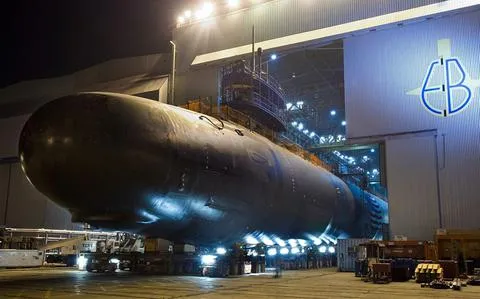BREMERTON, Wash. -- The Navy officially has a new "backbone" of its submarine fleet that is bigger, faster, quieter, and has more endurance and firepower than the Vietnam War-era design it passed by in sheer numbers this past summer.
Admirals, U.S. senators and other VIPs gathered April 5 at Naval Submarine Base New London in Groton, Conn. Sailors in dress blue uniform were given the traditional command: "Man our ship and bring her to life." They ran up the gangplank to formally commission the new Virginia-class attack submarine USS Iowa.
On July 25, a smaller gathering at Naval Base Kitsap, in Washington state, marked the decommissioning of the USS Helena, a Los Angeles-class attack submarine.
"For nearly 40 years she has operated in the silent, unseen depths -- a critical spearhead in our nation's defense," said Cmdr. Kyle Jones, commander of the boat.
The ceremonies represented a tipping point for the Navy.
The Iowa is the 24th Virginia-class sub to enter Navy service. The Helena's exit leaves the Navy with 23 Los Angeles-class submarines that entered service from 1976 to 1996. The Navy also has three 1990s-era Seawolf-class attack submarines.
Navy promotional materials in recent decades have touted nuclear-powered attack submarines as "the backbone" of the undersea fleet.
Bryan Clark, a former Navy submariner who's now a senior fellow at Hudson Institute, a Washington, D.C., think tank, said having the number of Virginia boats surpass Los Angeles boats is good news for modernizing U.S. national defense.
"The Virginia class is the jack-of-all-trades for the Navy," Clark said. "It's simply more sophisticated than the Los Angeles class."
Until this year, the most numerous attack submarine in the U.S. Navy was a design that started construction in 1972 -- the year the keel was laid for USS Los Angeles.
The 7,800-ton Virginia class is designed to remain submerged for up to three months, moving through the water at 25 knots with four torpedo tubes and 12 vertical-launching Tomahawk cruise missile tubes.
Clark said the Virginia class not only outperforms the Los Angeles class but should also best the Russian Akula class and Chinese Shang-class in the competition for dominance of nuclear hunter-killer submarines. He added that it has better "acoustic silencing" of noise as it prowls the seas and a more sophisticated sonar array.
"It's the quietest submarine we've ever had," Clark said
The majority of Virginia-class submarines were initially assigned to homeports where they could shadow Russia's more advanced submarines, particularly in the Arctic regions. But the recent assignment of the USS Minnesota to Guam and the arrival in Hawaii of more Virginia-class subs, such as the USS Montana, shows the Navy is starting to spread out its most modern submarine. The Virginia-class is now operating in the south and central Indo-Pacific region, where China is the major "peer adversary."
So far, the strategic Achilles' heel of the Virginia class has been its slow pace of construction.
The Navy currently has 50 attack submarines at a point when the Pentagon had hoped to have 66 arrayed around the world.
Mark Cancian, a retired Marine colonel and senior adviser at the Center for Strategic and International Studies think tank in Washington, D.C., said that the reason the Virginia class is the most numerous Navy attack submarine today is largely due to the speed with which the Los Angeles-class subs have been retired. The Virginia program, meanwhile, has had production delays due to the COVID-19 pandemic and industrial reductions after the Cold War.
"We're at the bottom of the bathtub, with the lowest production rate for submarines since the 1990s," Cancian said.
When approved by Congress in 1999, the Navy's plans for the Virginia-class subs called for building two to three each year with a price of about $2.8 billion each, the service wrote. Production would end in 2043, with the last boats leaving service in the 2070s.
The two shipyards building submarines -- General Dynamics Electric Boat, in Groton, Conn., and HII-Newport News Shipbuilding, in Virginia, have turned out an average of 1.2 boats per year.
A 2024 Navy analysis showed that the Virginia program suffered from $17 billion in cost overruns and delays, and production was two to three years behind schedule.
Costs for each Virginia-class submarine continue to rise. The newer Block IV models, which include an extended weapons bay, cost $4 billion each, according to the U.S. Naval Sea Systems Command.
While the transition from the Biden to the Trump administration has brought significant changes to many policies and programs, the Virginia-class submarine program has drawn both bipartisan support and criticism.
Democrats and Republicans have decried the slow production cycles for submarines -- a problem plaguing almost every Navy ship construction program, from Gerald R. Ford-class aircraft carriers to Constellation-class frigates.
Navy and political leaders have pointed to submarine construction as the nation's No.1 naval priority.
Lloyd Austin, the defense secretary under President Joe Biden, called the Virginia-class "the apex predator" of the world's oceans during congressional testimony last year.
In 2017, President Donald Trump gushed about the Virginia-class attack and new Columbia-class ballistic missile submarines.
"The most powerful machines ever built, and nobody knows where they are," Trump said.
